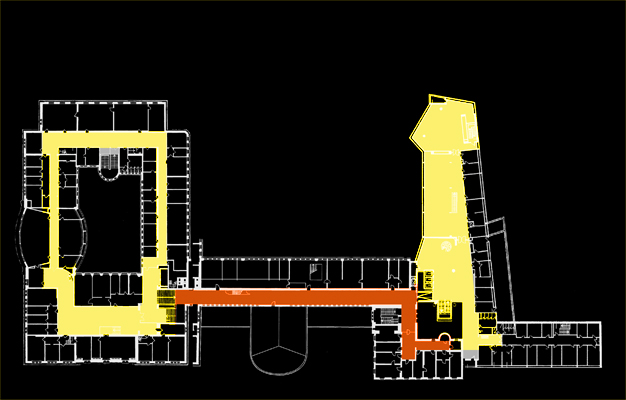 |
|
||||||||||

|
Maps, Room Numbers and Wayfinding Strategies – Investigations in a Very Complex BuildingA collaboration with the Centre for Cognitive Science Freiburg, and the Max-Planck-Institute for Biological Cybernetics,Christoph Hölscher (U Freiburg), Tobias Meilinger (MPI), Georg Vrachliotis (ETH), Markus Knauff (MPI)  contact: Georg Vrachliotis
Wayfinding in a complex setting with less than perfect knowledge requires decision making under uncertainty and we aim to identify the behaviors and strategies that people employ to navigate in such environments. The level of information available to the wayfinding person might be a key contributor and we are investigating if the standard wall-mounted floor maps found in most public buildings can help to properly navigate in a complex little-known environment.
This experiment investigated the role of expertise, map usage and in-struction on wayfinding strategies, tactics and performance. 32 participants had to find eight goals in a multilevel building consisting of two distinctive parts. Their verbalizations and performance were recorded with a camera. Experts showed clearly better performance whereas maps did not improve performance. If anything, participants performed worse. The hierarchical strategies of reaching the correct building part first versus reaching the correct floor first were mainly applied according to task affordances and instruction. In accordance with the architectural structure of the building, changing the building first led to better performance. A systematic search for the goal in the correct floor showed at least as good a performance as using maps
contact: Georg Vrachliotis
Wayfinding in a complex setting with less than perfect knowledge requires decision making under uncertainty and we aim to identify the behaviors and strategies that people employ to navigate in such environments. The level of information available to the wayfinding person might be a key contributor and we are investigating if the standard wall-mounted floor maps found in most public buildings can help to properly navigate in a complex little-known environment.
This experiment investigated the role of expertise, map usage and in-struction on wayfinding strategies, tactics and performance. 32 participants had to find eight goals in a multilevel building consisting of two distinctive parts. Their verbalizations and performance were recorded with a camera. Experts showed clearly better performance whereas maps did not improve performance. If anything, participants performed worse. The hierarchical strategies of reaching the correct building part first versus reaching the correct floor first were mainly applied according to task affordances and instruction. In accordance with the architectural structure of the building, changing the building first led to better performance. A systematic search for the goal in the correct floor showed at least as good a performance as using maps
-- GeorgVrachliotis - 10 May 2005
| ||||
This website has been archived and is no longer maintained.
